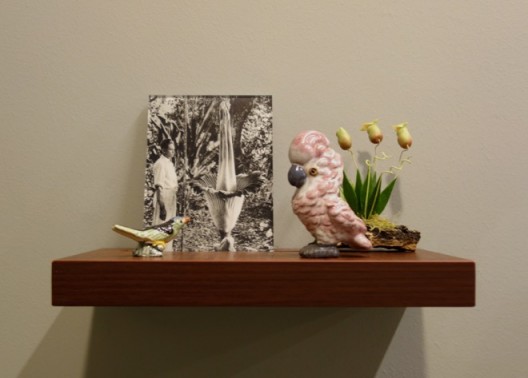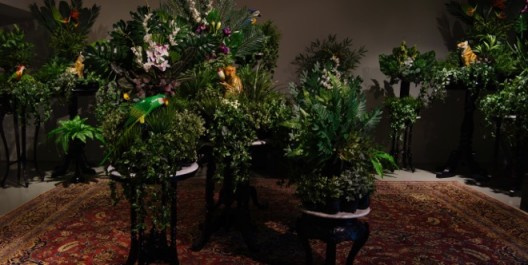This review is included in Ran Dian’s print magazine, issue 3 (Spring 2016)
“My Forest Has No Name” – Donna Ong solo exhibition
FOST Gallery (1 Lock Road #01-02, Gillman Barracks Singapore 108932), Jan 16 – Feb 28, 2016
Forests and jungles have been seen as anything from bastions of harmonious tranquility to wolf-haunted wastelands or tracts of resources to be cataloged and exploited. As a continuation of Donna Ong’s 2014 work “Letters from the Forest”, that last perspective—of the natural world as a thing to be subdued by intrepid colonialists—assumes greater significance, but her latest solo exhibition, “My Forest Has No Name”, is far from limited to that single perspective.
![王美清,《吾林莫名(xxiii)》,diasec工艺装裱,35 × 60 cm,2016(摄影: Fotograffiti [John Yuen], Eric Tschernow和Jason Lau)/ Donna Ong, “My Forest Has No Name (xxiii)”, diasec print, 35 × 60 cm, 2016 (photography: © Fotograffiti [John Yuen], Eric Tschernow and Jason Lau)](http://www.randian-online.com/wp-content/uploads/2016/04/Donna-ONG-My-Forest-Has-No-Name-xxiii-2016-Diasec-print-H35-x-W60-cm.-Photography-©-Fotograffiti-John-Yuen-Eric-Tschernow-and-Jason-Lau1-528x308.jpg)
王美清,《吾林莫名(xxiii)》,diasec工艺装裱,35 × 60 cm,2016(摄影:
Fotograffiti [John Yuen], Eric Tschernow和Jason Lau)/ Donna Ong, “My Forest Has No Name (xxiii)”, diasec print, 35 × 60 cm, 2016 (photography: © Fotograffiti [John Yuen], Eric Tschernow and Jason Lau)
The first impression upon entering the gallery is one of sensory saturation—sheer, verdant overload. It is first and foremost a visual impression, but soon other senses begin to awaken; there’s a hint of scent that hangs in the air of the gallery, though it is wholly lacking in vegetal or floral odors—or indeed of anything living. The likely culprit is some accumulation of esters, phthalates, and other volatile organic compounds given off by the profusion of plastic plants that populate a sort of urban garden tableau.
This luminous greenery is accented by gaudily painted animal figurines—the sort that infest tourist-trap souvenir shops—as well as wood and marble display stands that, as the curator Tony Godfrey notes in the exhibition’s accompanying essay, are of unknown provenance. The question of whether they’re cheap reproductions or valuable antiques is left open. Amid the deliberate luridness of “From the Tropics with Love” (2016) are set a number of tiny, delicately layered dioramas—part of a group of works called Gift Series: Pluvia Silva (2016)—featuring backlit scenes of the tropics as they might have been rendered by the likes of William Farquhar and other eighteenth-century gentleman-naturalists.
![王美清,《吾林莫名(xxvi)》,diasec工艺装裱,35 × 60 cm,2016(摄影: Fotograffiti [John Yuen], Eric Tschernow和Jason Lau)/ Donna Ong, “My Forest Has No Name (xxvi)”, diasec print, 35 × 60 cm, 2016 (photography: © Fotograffiti [John Yuen], Eric Tschernow and Jason Lau](http://www.randian-online.com/wp-content/uploads/2016/04/Donna-ONG-My-Forest-Has-No-Name-xxvi-2016-Diasec-print-H35-x-W60-cm.-Photography-©-Fotograffiti-John-Yuen-Eric-Tschernow-and-Jason-Lau1-528x308.jpg)
王美清,《吾林莫名(xxvi)》,diasec工艺装裱,35 × 60 cm,2016(摄影:
Fotograffiti [John Yuen], Eric Tschernow和Jason Lau)/ Donna Ong, “My Forest Has No Name (xxvi)”, diasec print, 35 × 60 cm, 2016 (photography: © Fotograffiti [John Yuen], Eric Tschernow and Jason Lau
The exhibition’s eponymous photographic series, however, foregrounds another aspect of our complex and storied relationship with the natural world. Each photograph depicts a landscape that on cursory inspection appears natural, while at the same time being the product of human artifice (a case in point being the domed gardens of Singapore’s billion-dollar “nature park,” Gardens by the Bay). With a theme that reaches back to the biblical book of Genesis and before, these somewhat Ballardian images suggest an impasse between us and nature—that we love it in simulation as some artful appearance of wildness. Then again, perhaps such a distinction is moot in the Anthropocene.
One final aspect of that same, tangled relationship unfolds in the exhibition’s sanctum sanctorum, an aspect that perhaps seems related to Werner Herzog’s observation in the 1982 documentary Burden of Dreams: “It’s just—nature here is vile and base. I wouldn’t see anything erotical here. I would see fornication and asphyxiation and choking and fighting for survival and . . . growing and . . . just rotting away.” Entitled “Deep Calls to Deep” (2016), the work consists of a dimly lit room dominated by a glossy pit of glittering black sand and walls lined with white-on-black vinyl prints of extracts from various texts. These range from naturalists’ memoirs to newspaper headlines addressing subjects of both benign interest and stomach-turning fascination: forest fires, mass graves, armies of slaves toiling in the Brazilian rainforest, Miss Peruvian Rainforest 2015, and so on. Sifting through the pit of black sand, one might find various oddments linked to these stories: a child’s shoe, a plastic femur, cosmetics. It calls to mind both the implacable indifference of the forest and our relentless fascination with it.
Taken on its own, “Deep Calls to Deep” seems somehow false, like an inflatable plastic model approximating some deeper structure; perhaps it is the heft of the plastic bone, or the specific texture of the sand between one’s fingers. Within the context of the exhibition as a whole, though—the plastic plants, the photographs of a constructed nature, and “Postcards from the Tropics” (2016), marrying schlocky souvenirs to images of tropical exploitation—this artificiality does not come across as a mere lack of authenticity, but as something that exists in its own right.
One may as well ask that “From the Tropics with Love” consist of living plants, antiques of ironclad provenance, and ethically sourced, fair-trade crafts. In addition to Ong’s central theme of the forest and the bizarre fantasies and clichés projected onto it, “My Forest Has No Name” may also be taken as an examination of our anxieties about authenticity, the murky boundary between nature and artifice, and some agonistic relationship between the represented and the representation.

![王美清,《吾林莫名(xxi)》,diasec工艺装裱,35 × 60 cm,2016(摄影:
Fotograffiti [John Yuen], Eric Tschernow和Jason Lau)/ Donna Ong, “My Forest Has No Name (xxi)”, diasec print, 35 × 60 cm, 2016 (photography: © Fotograffiti [John Yuen], Eric Tschernow and Jason Lau)](http://www.randian-online.com/wp-content/uploads/2016/04/Donna-ONG-My-Forest-Has-No-Name-xxi-2016-Diasec-print-H35-x-W60-cm.-Photography-©-Fotograffiti-John-Yuen-Eric-Tschernow-and-Jason-Lau1-245x245.jpg)

